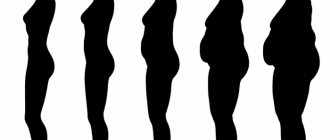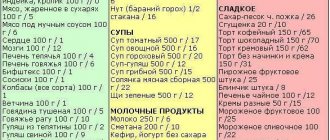The process of absorption of carbohydrates into the human blood is influenced by a number of factors, and this is not only the breakdown process.
- Simple carbohydrates have the simplest molecular structure and are therefore easily absorbed by the body. The result of this process is a rapid increase in blood sugar levels.
- The molecular structure of complex carbohydrates is somewhat different. For their absorption, preliminary breakdown into simple sugars is necessary.
For a diabetic patient, it is not just an increase in sugar levels that is dangerous, but its rapid increase. In this situation, carbohydrates are rapidly absorbed in the gastrointestinal tract into the blood, which is also quickly saturated with glucose. All this leads to the appearance of hyperglycemia.
Fast carbohydrates
Fast carbohydrates include monosaccharides, or “simple carbohydrates,” and disaccharides, which contain two monosaccharides. These are carbohydrates such as:
- glucose;
- fructose;
- sucrose;
- maltose and others.
The most common type of fast carbohydrate in food is glucose. How do fast carbohydrates affect the body? Glucose, like other monosaccharides, is quickly absorbed by the body and provides a lot of energy. But this energy is consumed just as quickly, and excess insulin, which ensures the absorption of glucose, causes a feeling of hunger.
How to burn carbs
Carbohydrates are a source of energy. In order for the body to spend treasured reserves, you need to move a lot and lead an active lifestyle. Just imagine how much energy it takes to run a cross-country race, lift a barbell, or climb to the 9th floor of a house. To force the body to remember about the stored reserves, you need to adhere to the following recommendations:
- Eat right before training. Your favorite chocolate bar or ice cream before a run will do this. Then the body will seem to remember that it has sugar reserves - the coveted glycogen.
- Train as long as possible. The intensity of the workout greatly affects how much reserves are used. The longer the session lasts, the more energy is required, and the more the body will take on treasured reserves.
- Choose aerobic exercise. Aerobics saturates the body with oxygen, which is necessary for burning glycogen.
- Build muscle. The more muscles you have, the more energy they require.
Video about carbohydrates:
Slow carbohydrates
Slow carbohydrates, unlike fast carbohydrates, are more complex compounds called polysaccharides. Slow carbohydrates include:
- starch;
- glycogen;
- cellulose;
As their name suggests, slow carbohydrates are absorbed by the body over a long period of time and the longer the faster carbohydrates, they saturate the human body with energy.

Factors that affect carbohydrate absorption
Let's name all the factors that directly affect the speed at which carbohydrates are absorbed.
- The structure of carbohydrates is complex or simple.
- Consistency of food intake – foods high in fiber promote slower absorption of carbohydrates.
- Temperature regime of food - chilled food significantly reduces the absorption process.
- The presence of fat in food - foods high in fat lead to slow absorption of carbohydrates.
- Special drugs that slow down the absorption process - for example, Glucobay.
Return to content
The effect of carbohydrates on human health
How do carbohydrates affect the body? Carbohydrates are the main source of energy for physical and mental activity. In addition, all types of carbohydrates are necessary for uninterrupted cell division, strengthening muscles and normalizing growth dynamics. It is worth noting that when the body is saturated with carbohydrates, overeating and lethargy after eating rarely occur. This is due to the fact that carbohydrates are quickly absorbed by the body, give a boost of energy and do not require much time.
A lack of carbohydrates in the diet results in the body breaking down proteins to obtain energy, which are more useful for restoring the body. The calorie content of proteins and carbohydrates is relatively the same.
Benefits of carbohydrates
Foods high in carbohydrates tend to taste good. For athletes, the effect of carbohydrates on the body is irreplaceable due to its energy intensity and rapid absorption.
Slow carbohydrates are more beneficial for the human body than faster ones. They provide the body with energy for a long time, are almost not stored as fat and, which is especially important for diabetes, maintain blood sugar levels.
Providing the body with energy is the main effect of carbohydrates - just for normal brain function, the amount of sugar required is 160 grams per day. Of course, we are not talking about the need to consume table sugar with spoons, but about all the sugars that are contained in food.
Harm of carbohydrates
The peculiarity of the body's absorption of glucose and other monosaccharides is that for this, the human gastric gland produces insulin. Insulin converts monosaccharides into the polysaccharide glycogen, which is deposited in the liver. With normal consumption of monosaccharides, this does not cause any harm, but if there is an excess of them in the blood, insulin converts monosaccharides into fatty acids and they are stored as fat. Usually, during a diet, fast carbohydrates are completely excluded from food consumption.
Products containing carbohydrates
Based on the rate of absorption, all products containing carbohydrates can be divided into the following groups:
- Containing “instant” sugar. As a result of their consumption, the concentration of sugar in the blood increases instantly, that is, immediately after or during a meal. “Instant” sugar is found in fructose, glucose, sucrose and maltose.
- Containing “fast” sugar. When consuming such foods, blood sugar begins to rise approximately 15 minutes after eating. These products are processed in the gastrointestinal tract within one to two hours. “Fast” sugar is contained in sucrose and fructose, which are supplemented by prolongators of the absorption process (apples can be included here).
- Containing “slow” sugar. Blood sugar concentrations begin to rise slowly about 30 minutes after eating. Products are processed in the gastrointestinal tract for two or more hours. “Slow” sugar is starch, lactose, sucrose, fructose, which are combined with a strong absorption prolongator.
Insulin therapy regimens, how the dose is distributed throughout the day, advantages and disadvantages of popular regimens Can diabetics eat butter? What does this mean and what beneficial properties are inherent in the oil?
Where to inject insulin? Which zones are considered the best and generally recognized and why?
Here are some examples to illustrate the above:
- Absorption of pure glucose, for example taken in tablet form, occurs instantly. Fructose contained in fruit juice, as well as maltose from kvass or beer, is absorbed at a similar speed. These drinks are completely free of fiber, which could slow down the absorption process.
- Fruits contain fiber, and therefore instant absorption is no longer possible. Carbohydrates are absorbed quickly, however, not instantly, as is the case with juices obtained from fruits.
- Food made from flour contains not only fiber, but also starch. Therefore, the absorption process here is significantly slower.
Return to content
Monosaccharides
These are the simplest compounds that make up more complex carbohydrates. They are usually clear, easily soluble solids in water. Most fast carbohydrates are monosaccharides - due to the fact that these are simple carbohydrate compounds, they are absorbed quickly by the body.
All monosaccharides are divided into two main groups:
1) Monosaccharides of open form (oxo form)
2) Monosaccharides are cyclic - they can twist and close into rings, which makes them more stable and more common.
Polysaccharides
Polysaccharides are complex carbohydrate compounds. They are made up of thousands of monosaccharide compounds. Based on their beneficial properties, polysaccharides are divided into three groups:
1) Structural polysaccharides – are responsible for the mechanical strength of cells, tissues and organs.
2) Water-soluble polysaccharides – keep cells and tissues from drying out.
3) Reserve polysaccharides - accumulate in cells and, if necessary, supply them with monosaccharides.
Many complex carbohydrates are difficult for the human body to digest and are called “dietary fiber.” The full mechanism of the effect of dietary fiber on the human body has not yet been studied, but today it is clear that they regulate the functioning of the intestines and affect the absorption of other chemical compounds. In addition, dietary fiber reduces the risk of diabetes.

All about medicine
Carbohydrates are part of any diet. They provide energy to the body for muscle work, breathing and brain functions among other activities. Carbohydrates contain some sugars. Sugars are often linked together and are called polysaccharides. So how are carbohydrates digested? The digestion process for carbohydrates begins in the mouth and ends when the polysaccharides are broken down into monosaccharides, which are then absorbed into the body.
Types of carbohydrates
The main types of carbohydrates are sugars, starches and dietary fiber. Answering the question “how are carbohydrates digested?” It is important to note that the body does not digest all types of carbohydrates. The body digests sugars and starches completely. When two carbohydrates are consumed, they provide 4 calories of energy per gram of carbohydrate. The human body lacks the necessary enzymes to digest or break down fiber. Consequently, fiber is removed from the body by excretion in large quantities.
How are carbohydrates digested?
Digestion of carbohydrates occurs in different parts of the body. Below is a breakdown of the activity in different parts of the body and the enzymes or acids each part releases.
- Mouth
The digestion process begins in the mouth, where saliva from the salivary glands moistens the food. When we chew food and break it into smaller pieces, the salivary gland releases the enzyme salivary amylase. This enzyme breaks down polysaccharides in carbohydrates.
- Stomach
Carbohydrates are swallowed in small pieces mixed with the enzyme amylase. This mixture is called chyme. Chyme passes through the esophagus into the stomach. The stomach releases acid, which does not digest the chyme further, but kills any bacteria in the food. In addition, the acid stops the function of the amylase enzyme.
- Intestines
The pancreas secretes a pancreatic enzyme in the small intestine that breaks down the saccharides in carbohydrates into disaccharides. Disaccharides are also called two-molecular sugars. Sucrose is an example of a two-molecular sugar. Other enzymes in the small intestine include lactase, sucrose and maltase. These enzymes break down disaccharides into monosaccharides. Monosaccharides such as glucose are also known as single molecule sugars.
A report from the Food and Agriculture Organization of the United Nations indicates that digestion of refined carbohydrates, such as sugar and wheat flour, occurs quickly. Digestion of such carbohydrates occurs in the upper end of the small intestine. Digestion of complex carbohydrates, such as whole grains, occurs in the lower end of the small intestine near the ileum. The ileum and small intestine contain villi, which are finger-like protrusions that absorb digested food. These projections vary depending on whether the diet is refined carbohydrates or whole grains.
- Liver
The liver stores monosaccharides as fuel for the body. The sodium-dependent hexose transporter is a molecule that transports one molecule of glucose and sodium ions into the epithelial cells of the small intestine. According to the University of Colorado, sodium exchanges with potassium in the bloodstream as the glucose transporter moves glucose in cells into the bloodstream. This glucose is stored in the liver and released when the body requires energy to perform its functions.
- Large intestine or large intestine
As stated earlier, the body digests and absorbs all carbohydrates except dietary fiber and some resistant starches. Bacteria found in the colon release enzymes that break down indigestible carbohydrates. This digestion process in the colon results in the formation of short-chain fatty acids and gases. Bacteria in the colon consume some fatty acids for energy and growth, while some are eliminated from the body in feces. Other fatty acids are absorbed into the cells of the colon and small amounts are transported to the liver. Dietary fiber is digested slowly in the gastrointestinal tract compared to sugars and starches. Therefore, consuming dietary fiber results in a slow and slight increase in blood glucose levels.
Simple and complex carbohydrates
We should always include carbohydrates in our diet. However, we need to understand how our bodies use different categories of carbohydrates, including simple (or bad) carbohydrates and complex (or good) carbohydrates. Answering the question “how are carbohydrates digested?” We can now differentiate between simple and complex carbohydrates and determine which of the two types is healthy.
Simple carbohydrates
Simple carbohydrates are made from basic sugars that are easily digested. These carbohydrates have little value for the body. Carbohydrates that are high in sugar and low in fiber are bad for your health.
Fruits and vegetables are included in the same category as cookies and cakes. They are all simple carbohydrates. However, fruits and vegetables are different from other foods in this category because they contain fiber, which modifies and slows down their digestion process in the body, making them very similar to complex carbohydrates. Sources of simple carbohydrates. Some carbohydrates you should avoid in your diet include soda, artificial syrup, and sugar. Others include white rice, pastries, desserts, white bread and white pasta. You can enjoy any of these foods from time to time, but they should not be your main sources of carbohydrates. Consuming baked potatoes, plain pasta or white rice is better than consuming chips, cookies or cakes. Complex carbohydrates Complex carbohydrates are made up of a longer series of sugars than simple carbohydrates. Hence, they are considered good carbohydrates and take longer to digest. Complex carbohydrates have a lower glycemic load. This means that small amounts of sugar are consistently released into your body throughout the day. Choose the right diet: You can include complex carbohydrates in your diet by replacing simple carbohydrates. For example, you can choose brown rice over white rice. You can also choose whole wheat pasta over white pasta. Now that you know the answer to the question, “how are carbohydrates digested?” Make the right choice when purchasing carbohydrates. Read package information to determine whether a food contains simple or complex carbohydrates. Whole grain, whole grain or fibrous ingredients indicate that the food contains complex carbohydrates.
About
Products containing mono- and polysaccharides
Eating foods high in carbohydrates normalizes the effect of fats and proteins on the human body. While carbohydrates are the main source of energy, when there is a lack of it, the body breaks down fats and proteins for energy.
Products with the highest content of monosaccharides: carrots, watermelon, fresh apples, prunes, raisins, dried apricots, dates, rose hips, grapes and honey.
Products containing polysaccharides: pumpkin, beets, potatoes, boiled corn, durum wheat pasta, peas, whole grain bread, oatmeal, buckwheat and rice. These products take a long time to digest, but do not contain fat and are well suited for dietary nutrition.
Grocery list
Remember that an excessive amount of fast carbohydrates in our diet will sooner or later lead to excess weight and obesity, even fatty hepatosis is possible. Foods that contain a lot of easily digestible carbohydrates are characterized by a high glycemic index.
Fast carbohydrates are found in all dishes that contain sugar. First of all, these are baked goods (pies, cakes), jams and preserves, sweet bars and even corn sticks. There are also a lot of these substances in products made from premium wheat flour. This means that they are found in large quantities in any baked goods and most types of bread. There are also a lot of them in pizza.
Simple carbohydrates are also found in some sugar substitutes and fruit sugar (fructose-based waffles and cookies, fructose casinaki, etc.). We are accustomed to not studying the composition of the product we buy in the market. And in vain. After all, the effect of fast carbohydrates is very gradual, and we may not feel it for years. But serious diagnoses will gradually appear if you do not monitor the quantities of these substances entering our gastrointestinal tract, and from there into the blood.
If a product contains a lot of fast (simple) carbohydrates), its glycemic index (GI) is more than 60. The diet should contain as little of such food as possible. Dates and raisins are no exception, which some people who are losing weight tend to consider as a dietary product. GI of dates: 103. The GI of the favorite drink of many, beer, is even higher - 110.
It is harmful to eat foods that contain starch. And it is often added to store-bought dairy products and baked goods. It is found in the simplest pasta and rice, as well as in corn flakes. This is why corn flakes are not the ideal breakfast. The GI of starch, by the way, is 100.
In butter buns, the GI is slightly lower, but also very high: approximately 95. The same glycemic index is assigned to fried and baked potatoes. White bread has a GI of 90, as does white rice (which “sticks together” when cooked). Therefore, it is advised to give preference to wild rice.
It is recommended to eat carrots raw, because when boiled or stewed, a lot of simple carbohydrates are formed in them. And then the GI of this supposedly healthy vegetable reaches a level of 85, about the same as that of hamburger buns and unsweetened popcorn.
Crackers are also not considered a diet food; they contain a lot of fast carbohydrates. Therefore, the GI of this product reaches the level of 80, like that of muesli with the addition of nuts and raisins. Even sweet donuts have a lower GI: an average of 76. The glycemic index is at 70 for a number of products:
- milk chocolates
- chocolate bars like Mars and Snickers
- croissants
- sweet sparkling water
- pearl barley
- soft wheat noodles
- Brown sugar
- semolina, etc.
The glycemic index tells how quickly carbohydrates are absorbed in the gastrointestinal tract. Other organic substances break down more slowly into simpler ones, so the level of glucose in the blood after their consumption does not spike.
Why are carbohydrates needed?
It should be remembered that all carbohydrates in foods are broken down in the body into glucose, which is a source of energy, stimulates thinking and mental activity, nourishes nerve cells, starts the processes of digestion and respiration, and is spent on physiological needs.
Therefore, it is not recommended to give up carbohydrates under any circumstances. You just need to determine which carbohydrates are healthy and which are harmful.
A deficiency of carbohydrate-containing foods in the diet leads to diseases of the heart and blood vessels, impairs memory, provokes headaches, muscle cramps, reduces concentration and the ability to perform mental stress. Therefore, it is important to know the optimal carbohydrate intake.
Absorption of healthy carbohydrates
Due to the fact that complex carbohydrates are absorbed gradually, they participate in a weight loss program and promote weight loss. To assess the usefulness of products, the glycemic index is used, which characterizes the rate of absorption of substances by the body. The amount of carbohydrates consumed per day is also important.
Potatoes are included in the list of complex carbohydrates, however, their glycemic index is high and they are quickly absorbed. In addition, potatoes contain large amounts of sugar. This must be taken into account when drawing up a carbohydrate menu for a diet.









